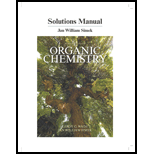
Concept explainers
(a)
To determine: The product of the given reaction.
Interpretation: The product of the given reaction is to be stated.
Concept introduction: Ninhydrin reacts with alpha amino acids to give resonance stablised anion known as Ruhemann’s purple accompanied by evolution of carbon dioxide. The side chain of amino acid is lost as an
(b)
To determine: The product of the given reaction.
Interpretation: The product of the given reaction is to be stated.
Concept introduction: Carboxyl benzyl is used to protect the
(c)
To determine: The product of the given reaction.
Interpretation: The product of the given reaction is to be stated.
Concept introduction: Acetic anhydride is commonly used for acylation of amino acids. All sorts of acylating agents can react with amino group of amino acids. Amino acids contain two major
(d)
To determine: The product of the given reaction.
Interpretation: The product of the given reaction is to be stated.
Concept introduction: Acetic anhydride is commonly used for acylation of amino acids. All sorts of acylating agents can react with amino group of amino acids. Amino acids contain two major functional groups: the amino group and the carboxylate group.
(e)
To determine: The product of the given reaction.
Interpretation: The product of the given reaction is to be stated.
Concept introduction: Nucleophilic addition takes place when hydrogen cyanide reacts with aldehyde or
(f)
To determine: The product of the given reaction.
Interpretation: The product of the given reaction is to be stated.
Concept introduction: Nucleophilic addition takes place when hydrogen cyanide reacts with aldehyde or ketones. Hydrogen cyanide attacks the carbonyl group of aldehydes and ketones to form cyanohydrin. It undergoes acidic hydrolysis to give carboxylic acid.
(g)
To determine: The product of the given reaction.
Interpretation: The product of the given reaction is to be stated.
Concept introduction: Carboxylic acids react with bromine and phosphorus tribromide to give
(h)
To determine: The product of the given reaction.
Interpretation: The product of the given reaction is to be stated.
Concept introduction: Carboxylic acids react with bromine and phosphorus tribromide to give
Want to see the full answer?
Check out a sample textbook solution
Chapter 24 Solutions
Student's Solutions Manual for Organic Chemistry
- What would you expect to be the major product obtained from the following reaction? Please explain what is happening here. Provide a detailed explanation and a drawing showing how the reaction occurs. The correct answer to this question is V.arrow_forwardPlease answer the question for the reactions, thank youarrow_forwardWhat is the product of the following reaction? Please include a detailed explanation of what is happening in this question. Include a drawing showing how the reagent is reacting with the catalyst to produce the correct product. The correct answer is IV.arrow_forward
- Please complete the reactions, thank youarrow_forwardConsider the synthesis. What is compound Y? Please explain what is happening in this question. Provide a detailed explanation and a drawing to show how the compound Y creates the product. The correct answer is D.arrow_forwardWhat would be the major product of the following reaction? Please include a detailed explanation of what is happening in this question. Include steps and a drawing to show this reaction proceeds and how the final product is formed. The correct answer is B. I put answer D and I don't really understand what is going on in the question.arrow_forward
- What is the product of the following reaction? Please explain what is happening in this question. Provide a detailed explanation and a drawing showing how the reagent is reacting with the catalysts to product the correct product. The correct answer is B.arrow_forwardWhat is the missing intermediate 1 and the final product 2. Please include a detailed explanation explaining the steps of malonic ester synthesis. Please include drawings of the intermediate and how it occurs and how the final product is former.arrow_forwardWhat would be the reagents and conditions above and below the arrow that will complete the proposed acetoacetic ester synthesis? If it cannot be done efficiently, then I will choose that answer. There could be 2 or 4 reagents involved. Please provide a detailed explanation and drawings showing how it would proceed with the correct reagents.arrow_forward
- For benzene, the ∆H° of vaporization is 30.72 kJ/mol and the ∆S° of vaporization is 86.97 J/mol・K. At 1.00 atm and 228.0 K, what is the ∆G° of vaporization for benzene, in kJ/mol?arrow_forwardThe reaction Q(g) + R(g) → Z(l) is shown to be exothermic. Which of the following is true concerning the reaction. it is spontaneous only at High T, it is spontaneous at low T it is nonspontaneous at all T it is spontanrous at all T. it is non spontaneous only at low T.arrow_forwardThe reaction Q(g) + R(g) → Z(l) is shown to be exothermic. Which of the following is true concerning the reactionarrow_forward
 Chemistry for Today: General, Organic, and Bioche...ChemistryISBN:9781305960060Author:Spencer L. Seager, Michael R. Slabaugh, Maren S. HansenPublisher:Cengage Learning
Chemistry for Today: General, Organic, and Bioche...ChemistryISBN:9781305960060Author:Spencer L. Seager, Michael R. Slabaugh, Maren S. HansenPublisher:Cengage Learning EBK A SMALL SCALE APPROACH TO ORGANIC LChemistryISBN:9781305446021Author:LampmanPublisher:CENGAGE LEARNING - CONSIGNMENT
EBK A SMALL SCALE APPROACH TO ORGANIC LChemistryISBN:9781305446021Author:LampmanPublisher:CENGAGE LEARNING - CONSIGNMENT
 Organic Chemistry: A Guided InquiryChemistryISBN:9780618974122Author:Andrei StraumanisPublisher:Cengage Learning
Organic Chemistry: A Guided InquiryChemistryISBN:9780618974122Author:Andrei StraumanisPublisher:Cengage Learning Principles of Modern ChemistryChemistryISBN:9781305079113Author:David W. Oxtoby, H. Pat Gillis, Laurie J. ButlerPublisher:Cengage Learning
Principles of Modern ChemistryChemistryISBN:9781305079113Author:David W. Oxtoby, H. Pat Gillis, Laurie J. ButlerPublisher:Cengage Learning




